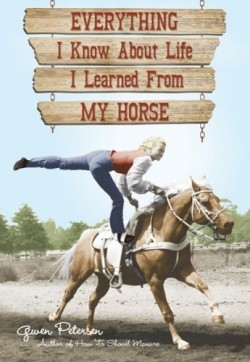Everything I Know About Life I Learned From My Horse
“There’s many a theory about whether animals have emotions, thoughts, and senses of humor. Whoever tries to tell you a horse doesn’t have those qualities, tell that individual to flake off.” Everything I Know About Life I Learned From My Horse is memorable book for its equine and human characters: a wandering, social butterfly of a horse who thinks he is a king; a ranch owner’s wife who collects “flamingo art, flamingo ceramics, and flamingo doodads” and a narrator who is consistently above-board with what’s on her mind. The narrator asks, “Why is ‘loins’ a plural word? Do people have more than one loin per body?” And the unsightly facts of living on a ranch and on the trail are certainly not beyond the margins of this text. One might expect this hilarious frankness from Petersen given the titles of her other books—How to Shovel Manure among them. This is an addition to the author’s portfolio that fits right in.
The cowgirl will feel at home in these pages; she is clearly the intended audience as the reader is addressed as a “horse aficionado.” However, because of the second-person point of view, perhaps readers of all walks of life—even those who have only encountered a horse’s rear in passing on the interstate—can imagine themselves in the saddle. For the benefit of those less acquainted with equines, a footnote indicates that riding drag “has nothing to do with kinky dress behavior.” The wry voice of the narrator at once advises on the arts of the Out West—how to answer nature’s call in a way that goes down in the memory books or how to fall off a horse—and assumes that the reader can recall these experiences too. To read this book is to join Petersen around a campfire, slapping knees together at the adventuresome blessing that is the horse life.
Each short chapter (with a couple of exceptions) begins with the phrase “wherein you learn.” Petersen punctuates this series with sing-song poetry. An advocate of pairing poetry and the equestrian, Petersen founded the Montana Cowboy Poetry Gathering and the Wintercamp Cowboy Poetry Gathering. A description of these events is included in this book.
Additional to the main body of the text is a running subtext provided in the book’s many footnotes. These con-tribute to the sense that the reader is getting the most intimate of portraits of the horse devotee. At once a humorous memoir and legitimate guidebook, this book is an up-close-and-personal introduction to the cowgirl’s days and the charm of the horses that fill them.
Disclosure: This article is not an endorsement, but a review. The publisher of this book provided free copies of the book to have their book reviewed by a professional reviewer. No fee was paid by the publisher for this review. Foreword Reviews only recommends books that we love. Foreword Magazine, Inc. is disclosing this in accordance with the Federal Trade Commission’s 16 CFR, Part 255.

